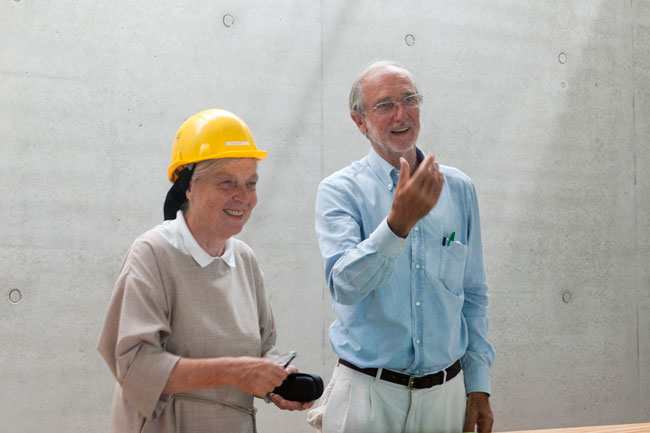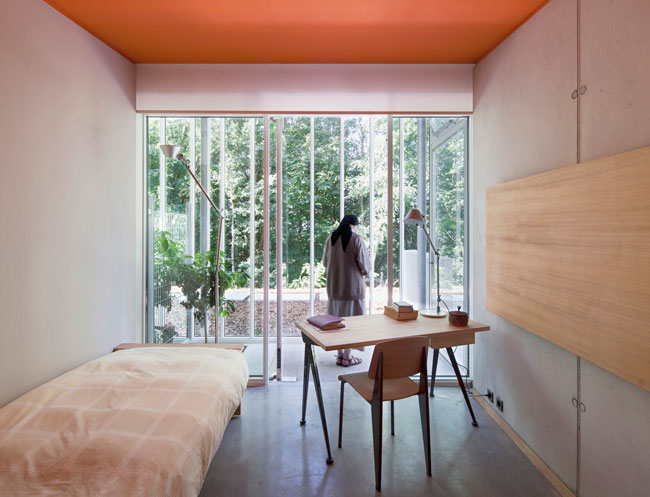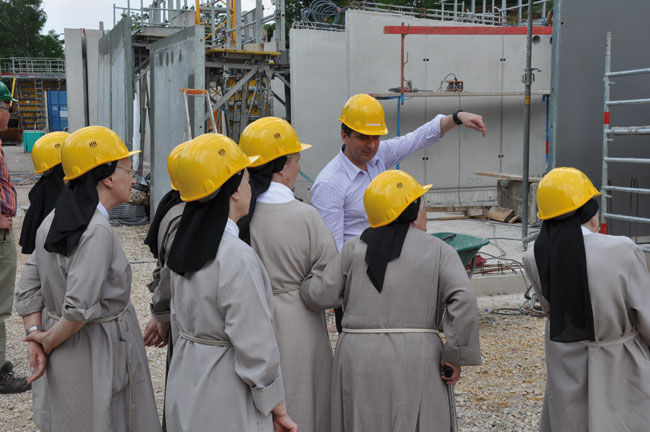Grand Opening for the Poor Clares at Ronchamp
/A cause for celebration. The new convent at Notre Dame du Haut, Ronchamp (sans its final landscaping) had its grand opening celebration in early September. ArchRecord has coverage and a photo gallery.

Vitality
I have written about this project and its controversial nature previously. Having reflected further on the problems of the project and the assumption that it reveals a conflict of identity & purpose in architecture, I have come to the following conclusion:
There is no singular work of architecture, no cult of an individual architect, and no inherent quality in architecture which can provide on its own a sufficient degree of sanctity so as to trump that brought by its in-dwelling, especially when that in-dwelling is liturgical in nature.
So much of the impetus to create architecture derives from the desire to make permanent an experience, to commemorate, to immortalize, to order the world in our own image. There is always an element of hubris in any architectural project. We forget the importance of the uncontrollable aspects of the life of a building: that buildings change, grow, decay, require upkeep and interaction. Their vitality is dependent upon life coursing through them and life takes its toll. The reality of a building defies the impetus of its creators.
Unless of course it is a monument or a tomb, and it can then allowed to be as dead as a work of art and uphold our fantasies of permanence and self-importance. But a church is never a monument or a tomb, even if it contain both; neither is she a work of art unless it be one which is always in progress.
This conflict may also be seen as two ideologies of preservation. Are we preserving a work of art, where the original state, experience, and intent of the auteur are the supreme guides? If so, to use the object is to harm it, and repairs can only be seen as an offense. Or are we preserving a building, where repairs are the normal part of a healthy life and its use what makes that life worth living?
In their argument to stop the project, the petition writers quote Le Corbusier as saying "Don t make changes ... I beg you. Keep it in its present, gripping state! ... Leave Ronchamp as it is for pilgrimages with the church which is suitable for pilgrimages."
How does that support the cause against the convent? A pilgrimage church, but who are the pilgrims? Architects or Catholics? And either way, a community of caretakers of the same family as those who were the original occupants and clients cannot but improve the site for pilgrims of either flavor. By returning some of the vocational vitality of the site by returning its liturgical life the church goes from a static museum of interest only to visiting specialists to an active part of a local community. And there is no greater purpose for any building.
The Petitions
The article on the ArchRecord site mentions a few of the well-known architects and which of the opposing petitions they signed. The list supports the idea that this conflict is one of form over use. Reading through the list of signers for both petitions and attempting to guess why certain people might be for or against made for an interesting mode of reflection on the significance of the project. There were many reasons on either side.
Those signing the petition in support include David Adjaye (see Idea Store) and Tadao Ando (see Chirstchurch Cardboard Cathedral, et al). There is nothing wanting in the form and even the architecture-cultural relevance of the work of either of these two architects; but the user and the mission comes first. Always. Seeing John Pawson on the side for was a little surprising, as he is generally associated with an aesthetically-driven minimalism; however, the sensitivity of his work at Our Lady of Nový Dvůr, Teplá does suggest that the aesthetics do not trump for him.
The FOR petition gathered 594 signatures in all (including a few duplicates and dubious entries). A quick read though the list turned up the following names I recognized in addition to those above. (There is no guarantee that these names are in fact the well-known individuals themselves.)
Massimiliano Fuksas, Architect Sir Peter Cook, Architect (Archigram) Frank Duff, Architect (pioneering researcher in the use of office buildings) Jan Kaplicky, Director Architect (of Future Systems) Cecil Balmond, Deputy Chairman, Ove Arup and Partners Limited (founder of AGU) Wil Alsop, Architect Ellsworth Kelly, Artist Sir Nicholas Grimshaw, Chairman of Grimshaw Architects and President of the Royal Academy of Arts, London Mark Di Suvero, Sculptor
Many of those signing the petition against the project are those I associate with a belief in the sanctity of art-in-itself. Richard Meier definitely falls into the attitude of "the architect knows best and to hell with the client." Cesar Pelli represents the very corporate side of the profession, where the prestige of the auteur architect must be guarded. On the extreme other end of spectrum of those who value the intent of the auteur architect is Juhani Pallasmaa, for whom it is less the form than the experience of the form that gives architecture its supreme meaning. Other prominent architects whose names apear on the petition against are Rafael Moneo and Robert Venturi.
There were also representatives of another force in architecture, one that would value the academic museumification of the "great works" of architecture for the sake of cultural posterity. Phyllis Lambert (Canadian Centre for Architecture founder), Wim de Wit (Head of the Department of Architecture and Design at The Getty Center), and Mary McLeod (Professor of Architecture History at Columbia University) fall into that category, as do many of the other academics, students, and practicing architects for whom Le Corbusier's chapel represent a foundational experience to be preserved for future students of architecture.
How the return of a religious order akin to the original inhabitants would not aid in the preservation is unclear. It is the difference between observing an animal in its habitat and pining a chloroformed specimen in a box.
The AGAINST petition had a total of 2117 signatures (including duplicates and humorous/insincere entries). Comparing the two also reveals a conflict between the UK/Japan (overwhelmingly) and Europe (overwhelmingly against). The petition against also had a large majority of its supporters from students of architecture who, based on the comments, were swooning over their idol.
In conclusion, I can't resist posting one more picture of nuns in hard hats!


